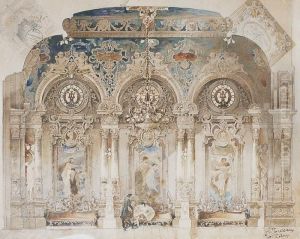Tussaud Paintings
Marie Tussaud, born Anna Maria Grosholtz in Strasbourg on 1 December 1761, was a French artist known for her wax sculptures and the creation of the Madame Tussauds wax museum, one of the major tourist attractions in London today. Her life was marked by her remarkable talent, entrepreneurial spirit, and a series of tumultuous events that mirrored the turbulent times in which she lived.
Marie's early life was steeped in tragedy and intrigue. Her father, a soldier named Joseph Grosholtz, died two months before she was born. Her mother, Anne-Marie Walder, took her to Bern, Switzerland, where she worked for Dr. Philippe Curtius, a physician skilled in wax modeling. Curtius recognized Marie's talent early on and became her mentor, teaching her the art of wax modeling. In 1765, Curtius moved to Paris to establish a cabinet of wax portraits, and Marie and her mother followed him shortly after. It was in Paris that Marie honed her craft, creating wax figures of famous personalities of the day.
The French Revolution proved to be a turning point in Marie's life. She was forced to prove her allegiance to the revolutionaries by making death masks of executed aristocrats, including Louis XVI, Marie Antoinette, and Robespierre. These grim tasks showcased her exceptional skill but also left her deeply traumatized. After the fall of the Jacobins, she was imprisoned for three months, narrowly escaping the guillotine.
In 1794, following Curtius's death, Marie inherited his collection of wax models. She married François Tussaud in 1795, and the couple had two children. However, her marriage did not distract her from her work. In 1802, she traveled to Britain to present her collection, intending the visit to be short. However, the outbreak of the Napoleonic Wars prevented her return to France. She spent the next 33 years traveling around Britain and Ireland, showcasing her wax figures in a series of exhibitions.
In 1835, Marie established her first permanent exhibition on Baker Street in London. The 'Chamber of Horrors,' one of the exhibition's most famous sections, included figures of those executed during the French Revolution, alongside criminals, murderers, and victims of the Plague. Marie Tussaud's ability to blend history, horror, and entertainment captivated the British public.
Marie Tussaud passed away in her sleep on 16 April 1850, leaving behind a legacy that has endured for centuries. Today, Madame Tussauds museums can be found in major cities around the world, each continuing to attract millions of visitors eager to see lifelike wax figures of celebrities, historical figures, and fictional characters. Marie Tussaud's life story is not just about the creation of a world-famous museum; it's about a woman who navigated the complexities of her era with skill and determination, leaving an indelible mark on the world of art and entertainment.
